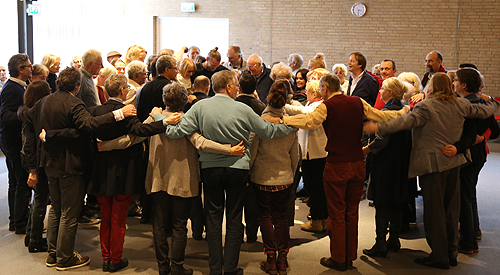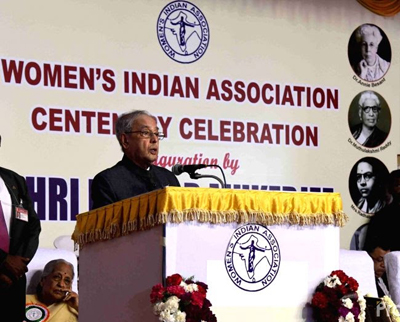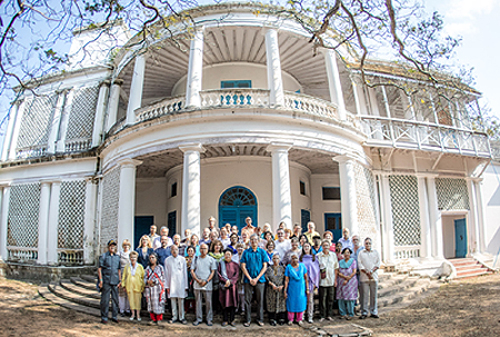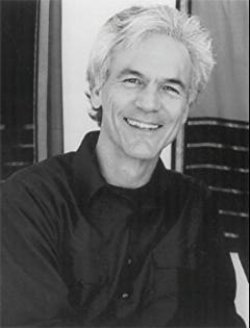Viewpoint: Final Thoughts
Printed in the Summer 2017 issue of Quest magazine.
Citation: Boyd, Tim, "Viewpoint: Final Thoughts" Quest 105:3(Summer 2017) pg. 6-7
Tim Boyd, President
A billion stars go spinning through the night
Blazing high above your head
But in you is the presence that will be
When all the stars are dead.
—Rainer Maria Rilke
 My father lived to the ripe old age of ninety-two. Except for his hearing, which eventually required him to turn up the television volume to the maximum and use a phone device that both flashed a light and made the phone ring loudly, he was in full possession of all his faculties. Toward the end of his life, he developed a habit which caused my almost equally aged, but totally active, mother some annoyance. After reading the daily newspaper or fiddling with one thing or another, he would sit for periods of time simply looking off into space. My mother is a great believer that the precious gift of time should be properly used, so when she would see him sitting idly, she frequently told him that he should get up and do something. True to the dynamics of a couple who had been married for more than sixty years, my father on more than one occasion complained to me that my mother did not understand. He was not just sitting idly, looking off into empty space. At the close of a rich life, filled with accomplishments, trials, failures, and friendships that spanned the globe and nine decades, in these apparently idle moments he said he was “remembering,” and that it was hard for my mom to realize how intensely active he was at those moments. He talked about the pleasure, the understanding, and the sometimes painful but purifying experience that flowed from calling up and reliving these memories with the benefit of the clarifying distance that time provides. For him it was joyful inner activity.
My father lived to the ripe old age of ninety-two. Except for his hearing, which eventually required him to turn up the television volume to the maximum and use a phone device that both flashed a light and made the phone ring loudly, he was in full possession of all his faculties. Toward the end of his life, he developed a habit which caused my almost equally aged, but totally active, mother some annoyance. After reading the daily newspaper or fiddling with one thing or another, he would sit for periods of time simply looking off into space. My mother is a great believer that the precious gift of time should be properly used, so when she would see him sitting idly, she frequently told him that he should get up and do something. True to the dynamics of a couple who had been married for more than sixty years, my father on more than one occasion complained to me that my mother did not understand. He was not just sitting idly, looking off into empty space. At the close of a rich life, filled with accomplishments, trials, failures, and friendships that spanned the globe and nine decades, in these apparently idle moments he said he was “remembering,” and that it was hard for my mom to realize how intensely active he was at those moments. He talked about the pleasure, the understanding, and the sometimes painful but purifying experience that flowed from calling up and reliving these memories with the benefit of the clarifying distance that time provides. For him it was joyful inner activity.
When cycles close and an extended period of effort comes to an end, it is a good time to look back and remember. Without even thinking about it, this is something we all do at birthdays, New Years, anniversaries, and, of course, at the close of a life. Having come to the end of my time as president of the Theosophical Society in America, in my few “idle” moments I too find myself looking back and remembering—looking for patterns of meaning in the intense activity of the past six years.
During H.P. Blavatsky’s time there was much talk about the siddhis and higher senses. At one point she made the witty, but accurate, comment that for people perhaps the rarest, but most necessary, sense of all was common sense, and that common sense is no lowly thing. It is the product of two things: intuition combined with experience. The great Muslim-Hindu mystic and poet Kabir said this: “What Kabir talks of is only what he has lived through. If you have not lived through something, it is not true.” In this, my last “Viewpoint” article, without being preachy, I would like to share two of the hard-won insights that have emerged over this time.
May of 2011, when I first took on the position of TSA president, was one of the most overwhelmingly active periods of my life. In addition to the details of winding up my business affairs, moving out of my home of thirty-plus years and settling my family in a new home at the Olcott national headquarters, I was completely absorbed in the preparations for the visit of His Holiness the Dalai Lama, who had been invited by us to give a public program in Chicago. A year earlier, then-president Betty Bland, her husband, David, my wife, Lily, and I had traveled to Iowa for an audience with him. A great deal of effort and preparation had been put into arriving at that moment. His Holiness is a busy man, with all manner of celebrities, politicians, spiritual luminaries, and common folk clamoring for his time. We had been given ten minutes. The meeting ended up lasting more than a half hour, during which he suggested that instead of the one-day event, which was all we felt we could hope for, his visit should extend over two days, with separate programs each day.
I remember the feeling of elation we all shared when we walked out of that meeting, and the sense that something of major importance was in store for the TS. When the initial high of our meeting and His Holiness’s wholehearted embrace of the TS started to die down (as such surges of emotion always do), we settled into a realization of the enormity of the task ahead. To us the Dalai Lama was a spiritual giant and a longtime friend of the TS, but this event would require more than appreciation and a warm glow. Gradually it became clear that in hosting a public event for 10,000 people with a man who is probably the most recognized person in the world, and who also required security arrangements equivalent to those for a head of state, we had moved into a realm where we had no experience. In the words of meditation teacher Jack Kornfield, “After the ecstasy, the laundry.”
Theosophist Clara Codd wrote a beautifully titled little book called Trust Yourself to Life. In it she elaborates on the simple but foundational quality of a trust born out of experience in the workings of the laws of life. Her basic message is that one of the fruits of genuine spiritual practice is an ever-growing sense of connection with the Self, the inner or higher self. In At the Feet of the Master, J. Krishnamurti had this to say: “You must trust yourself. You say you know yourself too well? If you feel so, you do not know yourself; you know only the weak outer husk, which has fallen often into the mire. But you—the real you—you are a spark of God’s own fire, and God, who is almighty, is in you, and because of that there is nothing that you cannot do if you will.”
Our studies and our deepest experiences confirm to us that, although our understanding of it is limited, the universe within which we live and move has an order. Whether it is the physical universe with its laws of gravity, electromagnetism, and thermodynamics, or the greater unseen universe with its laws of karma, cycles, and compassion, its function is unerring. For someone who truly understands this, the response of the mind and heart is cooperation and trust—the open, relaxed recognition that causes have effects, and that balance and limitless unfoldment are the nature of things.
These concepts came to life as experience in our Dalai Lama experiment. Because the requirements of the moment exceeded our known resources and capacity, we had to move beyond what we knew. The one thing that we did know was that our intention, the focus of our motive and will, was constant. We intended for the TS to be the agent for bringing a blessing to as many people as possible in the Chicago area. We also intended for all of the money that we received from the event to be donated for the use of the Tibetan people, particularly for the education of Tibetan medical professionals, who could service the health care needs of the Tibetan community in exile. The result was that all of the resources needed to accomplish our goal at the highest level invariably appeared. Every day, people, ideas, opportunities, and finances sought us out in order to make the vision a reality.
The principle that came to life during this time was “Trust yourself; trust others; the one is not different from the other.” Such a mindset leads to a sense of openness and ease in our daily lives. In practice, there will necessarily be times when our trust is misplaced and the inner reality we see and rely on is overshadowed by the force of habit. Occasional disappointment comes with the territory, but ultimately the optimist is always right. Spirit reveals itself when conditions allow.
In the spring of 2012, TS international president Radha Burnier came to the U.S. and spent a few days visiting with us at Olcott. At the time she had been president for more than thirty years. Throughout that time she had been a regular visitor to the U.S., but for a number of years we had not seen her at Olcott. On my first trip to the international headquarters in Adyar in 2011, I had invited her to come. Although we did not know it at the time, it was to be her last trip outside of India. As it turned out, an important part of her reason for the visit was to talk to me about considering the possibility of succeeding her in office. For me it was a very unexpected suggestion. At that time I had been serving as TSA president for a grand total of one year and had a very limited exposure to Adyar, or to the people and functioning of the international body.
Often when we engage in a line of thought, it has a clarifying effect. However, the more I allowed myself to consider Radha’s suggestion, the more unclear and unsettled I became. I had joined the TSA in 1974, and during the years that followed, at critical junctures in my Theosophical life I had sought out the counsel of Joy Mills, another past TSA president. Sometimes she would be positive, specific, and direct. At other times, while speaking, she would get a far-off look in her eyes, her voice would become soft, and the words emphatic. At those times the things she would say had an inscrutable quality and required time and a shift in perspective to grasp. When I shared my concerns about my conversation with Radha, Joy said a number of things, but finished with the enigmatic statement that what I must do is “Look for the open door.” Although it was not the advice I was expecting, it was exactly the reminder that I needed.
The obligatory pilgrimage that we call our life is an unscripted, infinitely creative process. There are overarching laws that define the range of choice available to us at any given moment. A fish swimming in a river can go in any direction—with the current, against the current, up or down—but it can’t move beyond the water. A human being can swim in water, walk on land, even fly, but is equally limited by the scope of his vision. As part of the lawful process, there is an ongoing process of unfoldment of consciousness, revealing previously unfathomed latent powers within us and continually extending our capacities and range of choice.
At every moment new possibilities are presenting themselves to us. Mostly we miss them because our habits and conditioning so limit our awareness that these possibilities pass unnoticed, like a stranger in the street. But there are times when, because of our own attention and effort, or our crisis and need, we become more sensitive to our inner environment. At times like these, we can become aware of the continually open door through which the renewing energies of the Higher Life are constantly streaming.
There are other less exalted but equally significant doors that open for us during the course of a life. Choosing a life partner, changing jobs, having children, embracing a new religion or life direction—in fact any act of profound commitment unveils an opening to a new world that has always been with us, but only becomes revealed as we commit.
Trust and always keep looking. It has been a good run.





 Light-headed, I was struck by the intense energy that came up under my foot, through my leg, and up to my head. I stayed standing, mostly steady, while the teacher’s arms caught my neighbor before she collapsed. I felt the heat. The three of us, with one foot each on the bundle of flowers and leaves beneath, were called from the class of eighty, gathered in a room in Utah’s Wasatch Range of the western Rockies, to cleanse more deeply. I, along with the others, had blown my prayers into a set of three dried bay leaves as our teacher guided us in this earthkeepers’ ceremony, known as kuti despacho, born long ago in the Andes Mountains of South America.
Light-headed, I was struck by the intense energy that came up under my foot, through my leg, and up to my head. I stayed standing, mostly steady, while the teacher’s arms caught my neighbor before she collapsed. I felt the heat. The three of us, with one foot each on the bundle of flowers and leaves beneath, were called from the class of eighty, gathered in a room in Utah’s Wasatch Range of the western Rockies, to cleanse more deeply. I, along with the others, had blown my prayers into a set of three dried bay leaves as our teacher guided us in this earthkeepers’ ceremony, known as kuti despacho, born long ago in the Andes Mountains of South America. When the twentieth-century astronomer Edwin Hubble began watching the galaxies, he discovered that the galaxy clusters were moving away from us in all directions. This leads us to the startling conclusion that, in terms of cosmic expansion, we find ourselves at the center of the cosmos. This is indeed a strange and most unexpected development.
When the twentieth-century astronomer Edwin Hubble began watching the galaxies, he discovered that the galaxy clusters were moving away from us in all directions. This leads us to the startling conclusion that, in terms of cosmic expansion, we find ourselves at the center of the cosmos. This is indeed a strange and most unexpected development. The sacred despacho ritual, a central practice of the Q’ero and Quechua peoples of the Andes, is used to honor Pachamama, Mother Earth, in daily ceremony. By creating a mandala-like bundle or offering, they create a gift to Pachamama and to spirit/creator. The gift is also used to transmit intentions of gratitude, using earth elements as the sacred messengers. It has been said that the paco, or priest, is a sacred chef, mixing ingredients from timeless recipes and creating a living prayer bundle, an act of love that honors a connection to all living beings.
The sacred despacho ritual, a central practice of the Q’ero and Quechua peoples of the Andes, is used to honor Pachamama, Mother Earth, in daily ceremony. By creating a mandala-like bundle or offering, they create a gift to Pachamama and to spirit/creator. The gift is also used to transmit intentions of gratitude, using earth elements as the sacred messengers. It has been said that the paco, or priest, is a sacred chef, mixing ingredients from timeless recipes and creating a living prayer bundle, an act of love that honors a connection to all living beings.